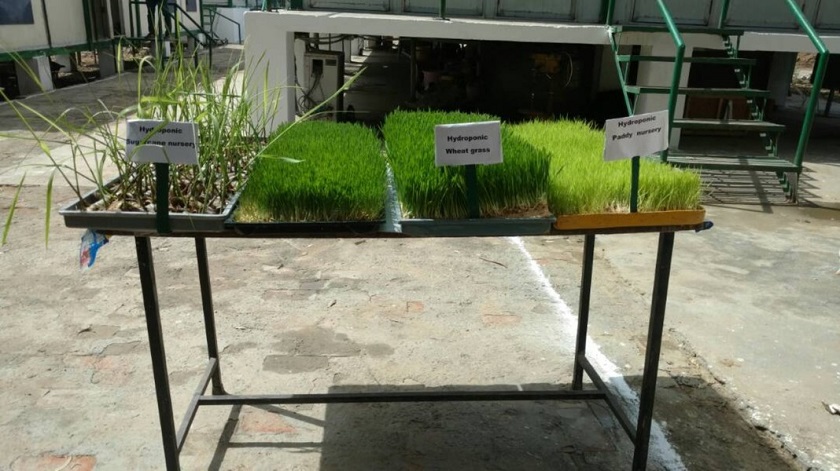A changing climate and thus an aggravating agrarian crisis is putting India at grave risk. Droughts and crop failure continue to plague the agro-rich zones of India, signaling an impending food crisis for the ever-growing Indian population. At such a juncture, the condition of the cattle and other farm animals is more pathetic. Pastures are drying up from the excessive heat and degrading soil nutrition. Even dried hay is becoming a scarcity in many places, let alone fresh, green fodder, especially during the scorching summer months. At such a juncture, a few regions in drought-infested Rajasthan seemed to have found an innovative solution, which can actually be the future of agriculture in India in the face of worsening climate and persistent water crisis. Using the method of hydroponics, non-profit veterinary organisation Ayurvet Research Foundation is growing fresh, green, chemical-free cattle feed in only seven days, using just two to three liters of water per kilogram of produce, whereas traditional farming consumes 80-90 liters for the same produce.
Hydroponics in India – Ayurvet’s Contribution

In India, hydroponics still remains an alien concept for most, except a handful of urban gardeners or organic farmers who practice it in constricted urban spaces. However, away from the limelight, Mr. Pradip Burman’s Ayurvet Ltd. is deploying the technique for the last 15 years, to aid the farmers in Rajasthan’s Bikaner, Udaipur and Jaipur. “Chemical-free fodder is key to safe milk production. With the constraint of declining agricultural land and water scarcity, Hydroponics Technology is really fulfilling the need of the hour,” says Mr Pradip Burman, Chairman of Ayurvet Group and a sustainability crusader supporting the technology. As explained by Mr. M.J Saxena, the Hydroponic innovator at Ayurvet Ltd., the green feed can be grown within a week in a controlled environment, from surplus seeds of maize and sorghum.
The history of hydroponics
The idea has been around for the past few centuries since English philosopher Francis Bacon brought forth the idea of growing plants without soil in his book Sylva Sylvarum in the year 1627. Over the centuries, the experiments on the idea grew more popular, more scientific advances continued but it never gained the mainstream limelight. In the 1930s, hydroponics was used by residents of Wake Island in the Pacifics, where they grew vegetables in this technique to supply for the passengers of the Pan-American Airlines, whose aircrafts used to stop over at the islands for refueling. Much later, a variety of hydroponic techniques were exhibited publicly at Walt Disney World’s EPCOT Centre.
Hydroponics did not come within the ambit of commercial cultivation until 2007, when a farm in Arizona, USA started marketing hydroponically grown organic tomatoes. Much later, Canada adopted the technique on a much larger scale in commercial greenhouses, where cucumbers, peppers and tomatoes are farmed. Space research had made profuse use of hydroponics as NASA considers it the future of farming if space travel ever becomes a reality. In fact, they have time and again experimented with the procedure by simulating outer space environments in their research centers.
How hydroponics is Saving the Lives of Farm Animals
Process: At first, the seeds are moistened abundantly and soaked in water dissolved with biopesticides and natural growth-enhancers. In a compact space, temperature and humidity are maintained at a constant to promote the highest growth rates for saplings, which are grown in shelves stacked one above the other. The requirement for a soil base is negated since the freshly sprouted roots get entangled in a compact mesh giving solid base support to the fast-growing saplings. The watering happens in a very interesting manner, making use of the trickle effect, where the residual water from the upper layer sieves down to the lower layer. The final excess water is collected in a tank placed at the bottom which is then recycled.
Hydroponics system gives better and healthier, 100% organic crops for the entire year, irrespective of seasonal climatic variations, but it also minimises the use as well as misuse of water, land and other natural resources. By growing cattle feed with hydroponics, Ayurvet experts have inferred that it indeed offers more land for food crop or cash crop cultivation. Moreover, the fresh, green and chemical-free feed improves the health of the cattle, immunising them from diseases and increasing milk production.
Lastly, the use of hydroponics since the system works more or less on its own once the initial set up is completed providing huge savings in human labor costs. At present, the main hurdle for mass adoption of hydroponics simply happens to be lack of awareness. It is high time the concerned government authorities take note of this amazing technique and take steps to popularise and make it available to the farming community. This would benefit the farmers, improve animal health and address the threat of climate change. We are truly glad to have organization’s like Ayurvet ltd. that are introducing such technologies/systems and helping India to achieve a better state of living on a faster growth pace.
Mr. Pradip Burman along with Ayurvet Ltd. has established many other organizations to achieve sustainability in India and contribute his efforts here. His initiatives include Mobius Foundation, Sanat Products Ltd., Ayurvet, Sundesh and Ages. Under the Mobius foundation he has also initiated the establishment of World Environment School, Coorg. Mr. Pradip Burman and Mobius Foundation are also amongst the key organizers of the ‘International Conference for Sustainable Education (ICSE) 2019’ in New Delhi in the month of September. All of these initiatives add great value to the welfare and maintenance of our environment and society. The future generation would truly be thankful to humans like Mr. Pradip Burman for help in saving the planet.
